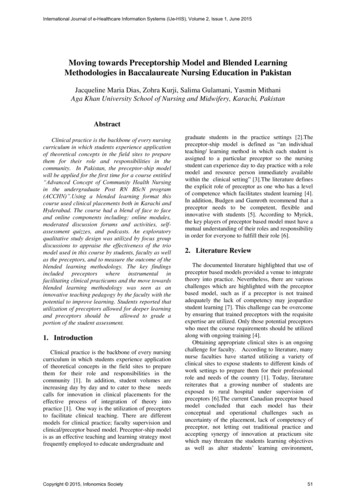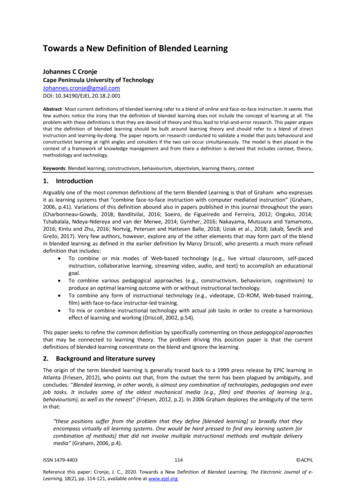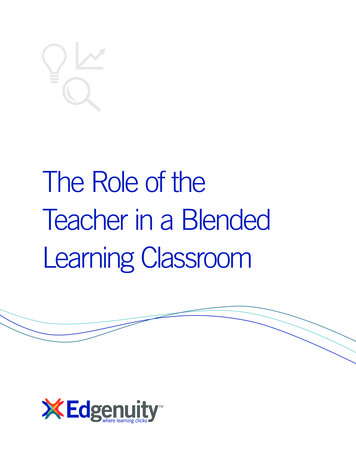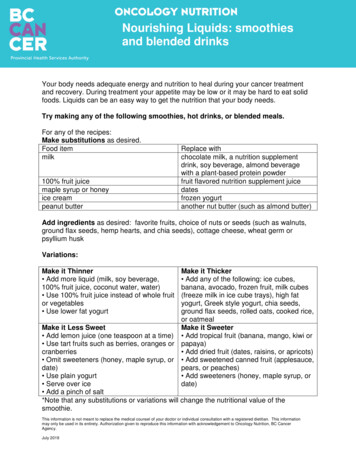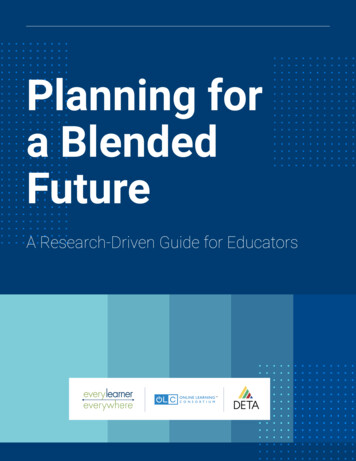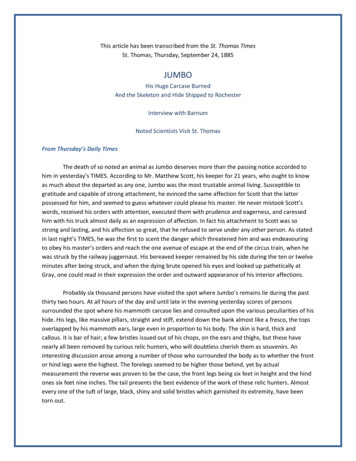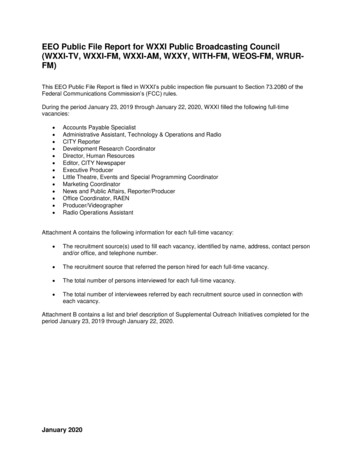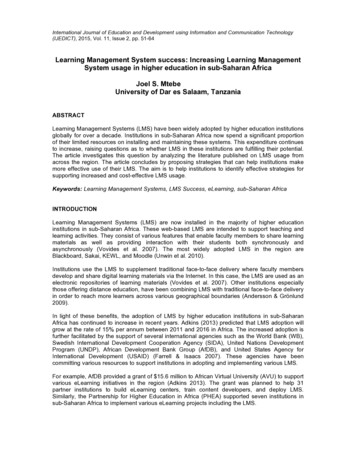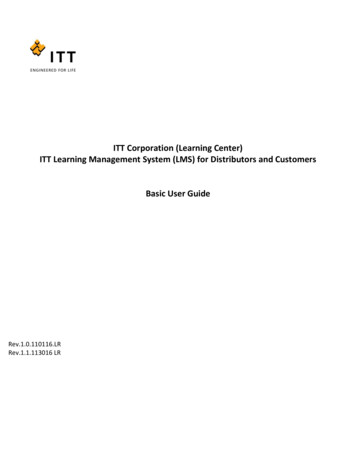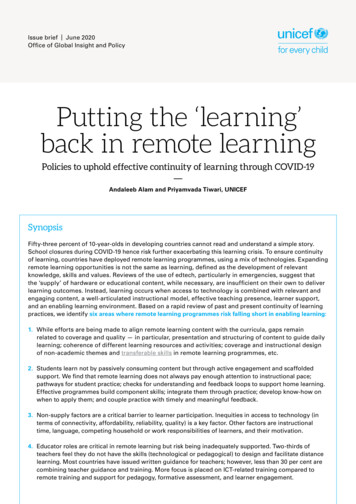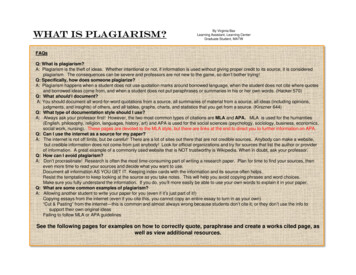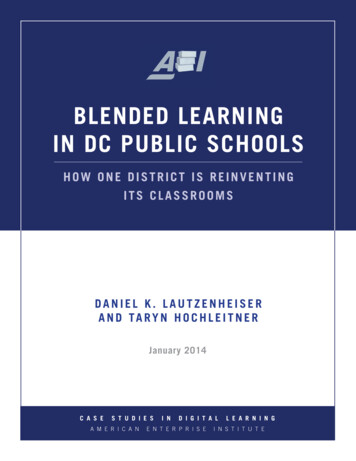
Transcription
BLENDED LEARNINGIN DC PUBLIC SCHOOLSHOW ONE DISTRICT IS REINVENTINGITS CLASSROOMSDANIEL K. LAUTZENHEISERA N D TA RY N H O C H L E I T N E RJanuary 2014C A S ES T U D I E SA M E R I C A NI ND I G I T A LE N T E R P R I S EL E A R N I N GI N S T I T U T E
ForewordIt is no secret that technology has transformed justabout every aspect of our lives, from how we watchmovies and listen to music to how we interact sociallyto how we buy cars and clothes. The same cannot besaid, however, for America’s K–12 school system. Whileadvances in modern technology offer an unprecedentedset of tools to reinvent the traditional classroom, inpractice each new generation of education technologyhas failed to do so.In our book Breakthrough Leadership in the DigitalAge (Corwin, 2013), Kaplan’s Bror Saxberg and I propose a smarter way to tap education technology’s capabilities to transform schooling. Too often leaders andeducators have used new technologies to tinker withoutdated practices rather than establish new and betterones. Instead, school leaders ought to become “learning engineers” by identifying the challenges they wantto solve, finding solutions in relevant science, and thenexploring how technologies can enhance those solutions. As Bror and I write, when used correctly, technology can make learning more affordable, available,reliable, customizable, and data rich.To illustrate how our ideas might play out in thefield, AEI has commissioned case studies exploring howa school and a district think about technology’s role intransforming schools. In this case study, my AEI colleagues Daniel Lautzenheiser and Taryn Hochleitnerlook closely at District of Columbia Public Schools(DCPS) forays into the digital learning world. In particular, DCPS has chosen to experiment with blendedlearning, which combines a mix of online learningand traditional teacher-led instruction. Lautzenheiserand Hochleitner are especially keen to zero in on thefolks in the DCPS central office, the teachers, and theprincipals—those on the ground who grapple with thehard work of transforming DC classrooms. In doingso, they profile both the promising opportunities ofblending learning and some of the challenges DCPSand similar urban districts face in getting it right.Lautzenheiser and Hochleitner explain, “In DCPS,rather than directing all schools to pursue the sameblended learning model, [the district has] embraced amore organic approach, encouraging such a transitionin schools they perceive to be most willing and able todo so. . . . They seem particularly interested in usingit as an improvement strategy in traditionally underperforming schools, where the administration is willing and the culture is ripe to try something new andbold.” The paper includes profiles of three ways ofusing blended learning in three different schools: station rotation at Randle Highlands Elementary School,the novel Teach to One math program at Hart Middle School, and the use of Discovery Education’s onlinetechbooks at Anacostia High School. Despite inevitable challenges such as technical glitches, helping teachers navigate new tools, and insufficient hardware, theauthors conclude that “the future is bright” when itcomes to blended models in the nation’s capital.We hope this case study is helpful in thinking aboutwhat it takes to implement a thoughtful blended learning strategy in a major urban district. I hope you will alsotake a look at the other paper in this series on Philadelphia’s Workshop School, written by Matthew Riggan,one of the school’s founders. For further information onDaniel and Taryn’s paper, they can be reached at daniel.lautzenheiser@aei.org or taryn.hochleitner@aei.org.For additional information on AEI’s education policyprogram, please visit www.aei.org/policy/education orcontact Lauren Empson at lauren.empson@aei.org.—FREDERICK M. HESSDirector of Education Policy StudiesAmerican Enterprise Instituteii
Blended Learning in DC Public Schools:How One District Is Reinventing Its ClassroomsBy Daniel K. Lautzenheiser and Taryn HochleitnerIt is a crisp, bright day in early November in Southeast Washington, DC. The setting is Anacostia HighSchool, a 697-student Title I school in DC’s Ward 8that has long been one of the district’s most chronicallyunderperforming schools. After giving a brief introduction to Japan’s geography and major cities, the socialstudies teacher we are observing asks her ninth-gradestudents to each pull out a netbook from a cart alongone of the classroom walls and log into an online portal.The portal is robust. Students can access an array ofmultimedia tools such as videos and interactive maps farbeyond the scope of a printed textbook. They can requestto hear passages read aloud and click on bolded termsto view their definitions. Each student can log in with aunique password, allowing them to customize their portal by taking notes and highlighting, and they can takeassessments online for immediate feedback. Students canaccess their portal from anywhere, including at home,and teachers can track individual student progress.Yet, as we watch, the students log in not withunique student-specific IDs but with generic ones.It takes one student almost five minutes to correctlyenter the password required to log in to the computeritself. Despite the online assessment capabilities, theteacher asks students to answer questions on a paperworksheet, meaning she will have to review each oneby hand that night. And at one point a student hastrouble understanding a word. With the entire scopeof human knowledge just a 0.21-second Google searchaway, the student gets out of her chair, walks over to abookshelf, picks up a dictionary, and starts slowly flipping through the pages.That particular anachronism—a 21st-centurystudent turning to Merriam-Webster instead ofWikipedia—highlights both the massive potential andthe stark realities of digital learning in today’s classrooms. Digital learning uses new technologies such aslaptops, iPads, and online content to enhance studentlearning. Many believe such practices have the potential to dramatically improve the learning and teachingexperience, and it seems every day heralds a new storyof school districts purchasing iPads in bulk or enthusiastic accounts of the next revolutionary online tool.But incorporating new technologies into schoolingin a way that actually improves learning is not as simpleas dropping laptops into a classroom and hoping for thebest. It is hard work, requiring a district or school to provide ample training for teachers, make smart decisionson which products to use, and be sure any new technological tools help (and do not hinder) academic goals,among a host of other considerations.Many highly publicized accounts of successful digital learning efforts tend to spotlight the bold vision ofa pioneering school or district leader, leaving less roomfor a description of what central office and school staffmust do behind the scenes to make those visions a reality. Such stories also tend to focus either on charterschool networks (such as the San Jose–based Rocketship Education) or on smaller traditional school districts (such as Mooresville Graded School Districtin North Carolina, whose one-to-one computer-to- student initiative has attracted national attention and aDaniel Lautzenheiser is the program manager in educationpolicy studies and Taryn Hochleitner is a research associate ineducation policy studies, both at AEI.1
BLENDED LEARNING IN DC PUBLIC SHOOLSDANIEL K. LAUTZENHEISER AND TARYN HOCHLEITNERkeynote address from President Obama). These effortsshould be applauded, but such examples tend to bemore the exception than the rule when it comes to therealities facing most schools.In this paper, then, we ask: what does it take to pursue a meaningful digital learning strategy in the large,urban districts that educate a significant percentage ofour nation’s kids?1 Thanks in large part to the tenureof former schools chancellor Michelle Rhee, DC hasbeen in the national spotlight for its pursuits in teacheraccountability and charter schooling, and it is seen bymany observers as one of the country’s leading districtsin school reform.How does digital learning fit into this school reformagenda? What progress has the district made, whatobstacles do its leaders face, and what lessons have theylearned? Answers to these questions will illustrate someof the steps other similar urban districts must take asthey grapple with the possibilities and challenges of digital classrooms.The goals are ambitious. The first, for example,aims for at least 70 percent of students to be proficientin reading and math by 2017 (only about 50 percentof students are at that level currently).5 In addition tothe Capital Commitment plan, for the 2013–14 academic year DCPS has specific goals to increase family engagement, attract highly qualified teachers andprincipals, and improve literacy instruction. Collectively, these goals drive most of the district’s currentinitiatives, including revamping libraries in 45 elementary schools to foster small-group literacy instruction,extending the school day in nine schools, and placingassistant principals for literacy and reading specialistsin 11 schools.6Using digital learning to transform theeducational experience is hard work.Another initiative the district is pursuing to advanceits academic goals is blended learning, a form of digitallearning that combines traditional teacher-led instruction with online instruction on the part of the student.Brian Pick, head of the DCPS Office of Teaching andLearning—which covers all matters of professionaldevelopment, formative assessments, enrichments,intervention, and curriculum design—explains, “Kayahas been a strong supporter of blended learning as asolution to accelerate student achievement. . . . Webelieve that ed tech and the blended learning solutionsthat are out there will help us reach our goals in theshort timeline we have.”7 This commitment is echoedby John Rice, who oversees DCPS forays into theblended-learning world: “Chancellor Henderson hasidentified five capital commitments that we’re tryingto reach by 2017. And we want our blended learningefforts to align with those as much as possible.”Welcome to DCWashington, DC, enrolled more than 80,000 studentsin 232 schools in the 2012–13 school year.2 More than40 percent of those students were in charter schools,leaving just over 45,000 students in 111 schools in theDistrict of Columbia Public Schools (DCPS)—a largedistrict, to be sure, but smaller than the likes of NewYork City (995,000 students) or Los Angeles (667,000students).3 Demographically, the student body is 72percent black, 14 percent Hispanic, and 10 percentwhite. Ten percent of students are English-languagelearners. In 2012, the district’s high school graduationrate was 56 percent.4To understand DCPS efforts in digital learning isto see first and foremost how they fit into the largerreform ecosystem Chancellor Kaya Henderson is fostering. In 2012, Henderson and Mayor Vincent Grayannounced a five-year strategic plan to improve DCschools. Called “A Capital Commitment,” the planset five goals: increase academic achievement, invest inchronically struggling schools, increase the high schoolgraduation rate, improve student satisfaction, andincrease enrollment.Blended Learning in the Nation’s CapitalBefore 2011, blended learning’s presence in Districtof Columbia classrooms was haphazard, appearingonly in places where enterprising teachers or administrators had decided to experiment on their own; a2
BLENDED LEARNING IN DC PUBLIC SHOOLSDANIEL K. LAUTZENHEISER AND TARYN HOCHLEITNERWhat Is Blended Learning?Put simply, blended learning is a mix of face-to-faceand online instruction. As DCPS explains, blended-learning models have “changed the role of technology in the classroom from that of a supportive tool intoan integrated component of instruction.”1 If “digitallearning” is the umbrella term for any learning experience that takes place at least partially online, blendedlearning implies some degree of redesigning the traditional lecture-based model of classroom instruction.This means a teacher is no longer solely responsiblefor delivering content to an entire classroom at once,but can use a mix of online tutoring, digital content,teacher-led lessons, and other methods to ensure thatstudents receive targeted instruction.Why pursue blended learning? These models signala departure from the “one-size-fits-all” lecture-basedclassroom. Blended learning offers a more personalized experience, usually by incorporating multiple ways of learning. In addition to providing aricher learning environment, Digital Learning Now(a nonprofit group supportive of such efforts) writesthat blended-learning models are more “productive”because they ensure that “the right resources and interventions reach the right students at the right time.”2Finally, the fact that students spend part of their timeworking online also creates the possibility for morereal-time data on student performance that teacherscan use to inform instruction.Notes1. District of Columbia Public Schools, “Blended Learning Executive Summary” (Version 1), Submitted by BlendedLearning Team, Educational Technology and Library MediaServices, Office of Teaching and Learning, Budget Responses,March 2013, www.dccouncil.us/files/user uploads/budgetresponses/Q8 Attachment DCPS Blended LearningExecutive Summary March 2013.pdf.2. Digital Learning Now, “Blended Learning Implementation Guide,” Version 2.0, September 2013, /10/BLIG-2.0-Final-Paper.pdf.centralized blended-learning strategy was nonexistent.One of those teachers was John Rice, who, inspired byMichelle Rhee’s reforms, left his high school teachingjob in Florida to move to Washington, DC. Duringhis three years of teaching at Anacostia High School,he started experimenting on his own with a number ofonline instructional tools to help his st
east Washington, DC. The setting is Anacostia High School, a 697-student Title I school in DC’s Ward 8 that has long been one of the district’s most chronically underperforming schools. After .
